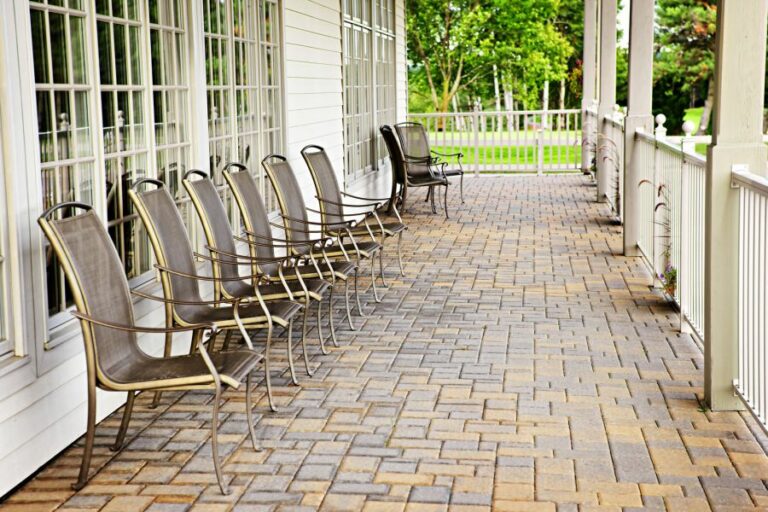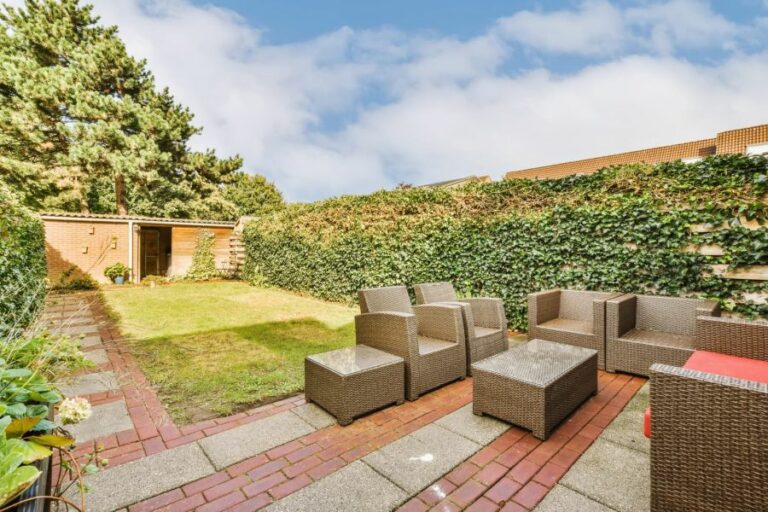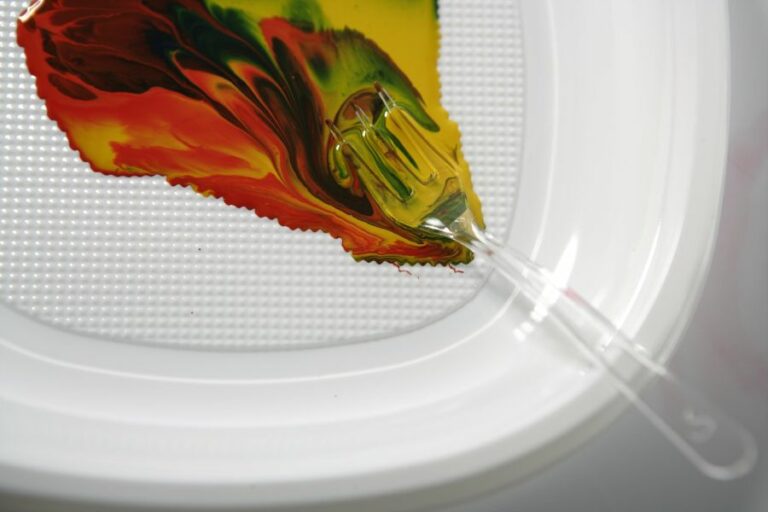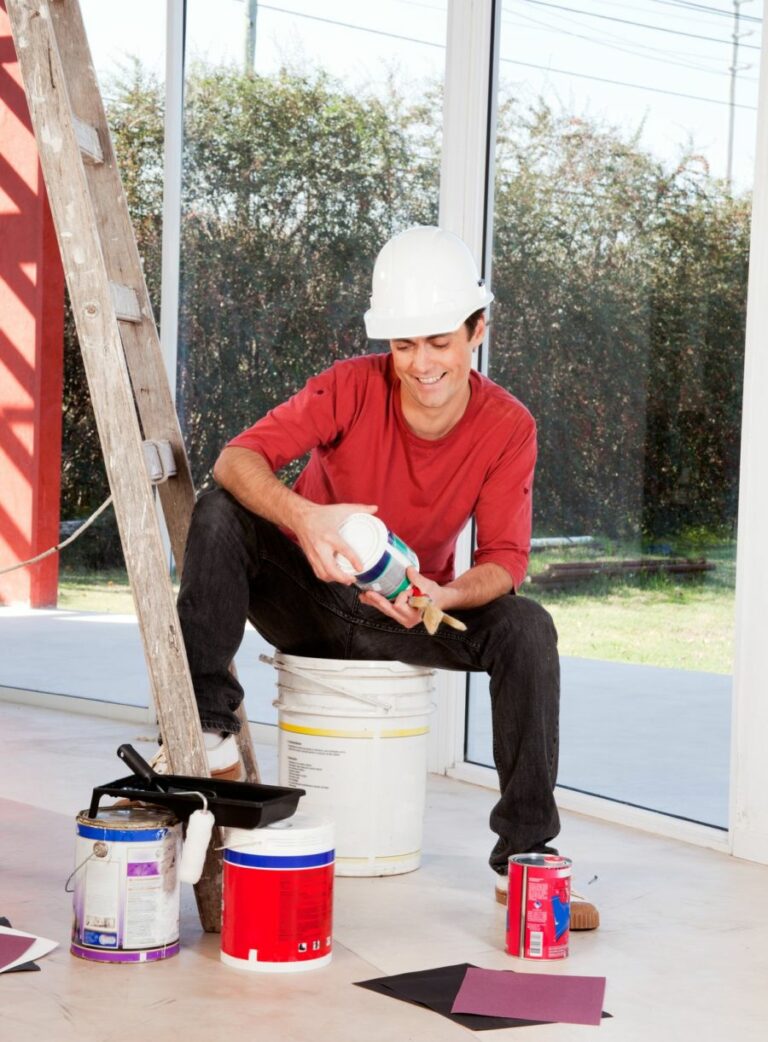How To Paint Outdoor Wood Furniture
Transform your outdoor space with a fresh coat of paint on your wooden furniture! Spruce up your new or weather-beaten chairs, tables, and benches easily while ensuring durability and longevity. So, grab your painting supplies and get ready to breathe new life into your garden or patio.
How to paint outdoor wood furniture:
This guide offers a step-by-step process on painting outdoor wooden furniture, including properly preparing your workspace and materials, inspecting and repairing any damages, sanding and cleaning the furniture, applying primer and paint, protecting the painted furniture with a sealant, and expert tips for a successful result. Key points include choosing a well-ventilated area for painting, using appropriate outdoor wood paint and primer, sanding the furniture thoroughly, and applying a protective sealant to ensure longevity and durability.

Discover expert techniques, tools, and materials required to transform your outdoor wood furniture with a fresh coat of paint. Enhance curb appeal, protect against weather damage, and unleash your creativity through our detailed, step-by-step guide. Let’s begin your DIY journey together!
Contents
- 1 Guide to Painting Outdoor Wooden Furniture: Techniques and Tips
- 2 What Type of Paint is Suitable for Wooden Outdoor Furniture?
- 3 Is Priming Necessary for Outdoor Wooden Furniture Prior to Painting?
- 4 Is it Possible to Paint Outdoor Furniture Without Sanding?
- 5 What is the process for preparing outdoor wood surfaces for painting?
Guide to Painting Outdoor Wooden Furniture: Techniques and Tips
Refreshing your outdoor wood furniture with a new coat of paint is an excellent way to transform your patio or garden space. Not only can it revive the appearance of your furniture, but it can also provide protection against weather elements.
• Prepare Your Workspace and Materials
Before you begin painting, preparing your workspace and gathering all the necessary materials is crucial.
– Workspace
- Choose a well-ventilated area, ideally outdoors or in a garage with an open door.
- Protect the ground where you’ll be painting by placing a drop cloth or plastic sheet beneath your work area.
- Ensure you have adequate lighting to see your work clearly.
– Materials
Gather the following materials:
- Outdoor wood paint
- Primer (if needed)
- Electric sander or sandpaper
- Painter’s tape
- Paintbrushes or paint rollers
- Clean cloth or tack cloth
- Wood filler (optional)
- Drop cloth or plastic sheet
- Protective gear (gloves, safety goggles, mask)
• Inspect and Repair Your Furniture
First, closely inspect the furniture for any damage, such as cracked or splintered areas. If you notice any damage, repair it before proceeding.
- Use a putty knife to apply wood filler to any damaged areas. Follow the manufacturer’s instructions on the filler’s package.
- Allow the filler to dry completely.
- Sand down the filled areas to create a smooth surface.
• Sand and Clean the Furniture
Sanding is an essential step to ensure proper paint adhesion and a smooth finish.
- Sand down the entire piece of furniture, starting with coarse-grit sandpaper (80-grit) and working up to fine-grit sandpaper (150 or 220-grit). Pay special attention to any rough areas, edges, and corners.
- Wipe away any dust and debris from the surface with a clean cloth. Avoid using a damp cloth, as this will introduce moisture to the wood.
- For more thorough cleaning, consider using a tack cloth, which is specially designed for picking up dust.
• Prime the Furniture
Applying a primer is necessary for certain types of wood or when using specific paint colors to ensure proper coverage and paint adhesion.
- Check the manufacturer’s instructions on your paint container to determine if a primer is recommended for your specific paint and wood type.
- If using a primer, apply it according to the manufacturer’s instructions using a paintbrush or roller.
- Allow the primer to dry completely before proceeding.
• Apply the Paint
Now that your furniture is properly prepped, it’s time to apply the paint.
- Stir the paint thoroughly to ensure proper consistency.
- Apply a thin, even coat of paint to the furniture, working in small sections. Use a brush for detailed areas and a roller for larger surfaces.
- Be mindful of any drips or uneven areas, and smooth them out immediately.
- Allow the first coat of paint to dry fully, according to the manufacturer’s instructions.
- Inspect the furniture for any areas that may need additional coverage, and apply a second coat if necessary.
- Allow the second coat to dry fully.
• Protect Your Painted Furniture
To ensure the longevity and durability of your newly painted furniture, protect it from the elements.
- Apply a clear, protective sealant specifically designed for outdoor wood furniture.
- Follow the manufacturer’s instructions for application and drying times.
- Allow the sealant to fully cure before using your furniture.
• Expert Tips and Tricks
- Consider testing your paint color on a small, inconspicuous area of the furniture before applying it to the entire piece. This will allow you to see how the color will look once it’s dried.
- To prevent brush strokes, use a high-quality paintbrush and apply the paint in long, even motions.
- When painting outdoor wood furniture, it’s crucial to use paint specifically formulated for exterior use. This will provide the necessary protection against weather, UV rays, and moisture.
- If your furniture has intricate details or tight corners, consider using a small, angled paintbrush for those areas.
- Keep an eye on the weather forecast and avoid painting on days with high humidity or the threat of rain. The best conditions for painting are moderate temperatures and low humidity.
In conclusion, proper preparation and technique are key to achieving professional-looking results when painting outdoor wood furniture. By following the steps outlined in this guide, you’ll be on your way to enjoying a rejuvenated and protected patio or garden space.
Step | Description |
|---|---|
1 | Choose the right paint: Select a paint specifically designed for outdoor wood furniture, such as exterior latex paint. |
2 | Clean the furniture: Remove dirt, dust, and mildew from the surface using a soft brush, mild soap, and water. Allow the furniture to dry completely before moving to the next step. |
3 | Sand the surface: Lightly sand the surface of the furniture using fine-grit sandpaper to remove any loose paint or rough spots. Wipe the furniture clean with a damp cloth to remove any dust. |
4 | Apply primer: If needed, apply a coat of primer to the furniture’s surface, allowing it to dry completely before moving on to the next step. Primer helps ensure better paint adhesion and an even finish. |
5 | Paint the furniture: Apply the first coat of paint to the furniture. Use long, even strokes, and be sure to cover the entire surface. Allow the first coat to dry for the time recommended on the paint can. |
6 | Apply additional coats: If necessary, apply additional coats of paint, allowing each coat to dry before applying the next one. Be sure to cover any areas that may have been missed during the first coat. |
7 | Protect the furniture: To help protect the painted surface from weather and wear, consider applying a clear sealant or topcoat once the paint is completely dry. |
What Type of Paint is Suitable for Wooden Outdoor Furniture?
Protecting and beautifying your outdoor wooden furniture is essential for prolonging its life and maintaining its appearance. The type of paint you choose can make all the difference in the final result.
• Exterior Paints: The Top Options for Wooden Furniture
When selecting paint for outdoor wood furniture, it is crucial to choose a product that offers excellent durability and protection against weather elements, such as rain, sun, and humidity. Here are the top three types of exterior paints perfect for wooden outdoor furniture:
– Latex-Based Paint
Latex-based paints are water-soluble and provide superior adhesion, making them ideal for outdoor wood furniture. They dry relatively quickly and are resistant to mildew and algae growth. Latex-based paints are also easy to clean, making maintenance a breeze.
Recommended Product: I recommend using an exterior-grade, 100% acrylic latex paint for optimal durability and protection. Look for a low-VOC (volatile organic compound) formula to minimize harmful emissions.
– Oil-Based Paint
Oil-based paints are known for their durability and rich, glossy finish. They create a harder surface on the wood, providing excellent protection against moisture and UV rays.
Although oil-based paints take longer to dry than latex-based paints, they generally last longer, making them suitable for outdoor applications.
Recommended Product: Choose a high-quality exterior-grade oil-based paint, preferably with a built-in UV inhibitor. This will ensure that your furniture is protected against the sun’s harmful rays and reduces the risk of fading or discoloration over time.
– Alkyd Enamel Paint
Alkyd enamel paints are a popular choice for outdoor wood furniture because they offer excellent durability, gloss retention, and stain resistance. They are also water-resistant, making them perfect for protecting your outdoor wooden furniture from harsh weather elements.
Recommended Product: I recommend using an exterior-grade alkyd enamel paint with a rust-resistant primer for an added layer of protection, especially if your furniture has metal components.
• Proper Surface Preparation: Key to Long-Lasting Results
Before painting your outdoor wood furniture, it is crucial to prepare the surface properly. This ensures the paint adheres well and results in a smooth, professional-looking finish. Follow these steps for optimal surface preparation:
- Clean: Thoroughly clean the furniture using mild detergent and water to remove any dirt, dust, or grime. Rinse the furniture with clean water and let it dry completely.
- Sand: Lightly sand the entire furniture surface to remove any loose or peeling paint and smooth out any rough areas. This will also help the new paint adhere better to the surface.
- Repair: Inspect the furniture for any damaged areas, such as cracks or splits in the wood. Fill any small gaps or cracks with wood filler, then sand the surface smoothly once the filler has dried.
- Prime: Apply a high-quality exterior-grade primer to the entire surface of the wooden furniture. This will create a smooth, even base for the final paint application and enhance the paint’s adhesion.
- Allow Dry Time: Allow the primer to dry according to the manufacturer’s instructions before applying paint.
• Painting Techniques to Enhance the Look of Your Outdoor Furniture
Proper application of paint is essential for achieving a smooth, uniform finish on your wooden outdoor furniture. Here are some tips for professional-looking paint application:
- Use Quality Brushes and Rollers: Invest in a high-quality brush and/or roller for a smooth, even application of paint. Brushes with synthetic bristles are suitable for latex and water-based paints, while natural-bristle brushes work best for oil-based or alkyd paints.
- Paint in Thin Coats: Apply the paint in thin, even coats to avoid drips and streaks. Applying multiple thin coats rather than one thick coat is better, as this allows for better adhesion and a more durable finish.
- Sand Between Coats: Lightly sand between each coat of paint to ensure a smooth, even surface. This also helps the subsequent coats adhere better.
- Allow Adequate Dry Time: Follow the manufacturer’s instructions for drying time between coats and before exposing the furniture to the elements.
• Regular Maintenance for Long-Lasting Protection
Regular maintenance is essential to keep your wooden outdoor furniture looking its best and prolong its life. Follow these steps for ongoing care:
- Clean Regularly: Clean your outdoor furniture regularly using mild detergent and water to prevent the buildup of dirt, debris, and mildew.
- Inspect for Damage: Regularly inspect the furniture for signs of damage, such as cracks, chips, or peeling paint. Address any issues promptly to prevent further deterioration.
- Reapply as Needed: Over time, exposure to the elements can cause outdoor paint to break down, making it necessary to reapply a new coat periodically. Monitor the condition of the painted surface and reapply the paint as needed to maintain the protective barrier.
By following these recommendations and choosing the right paint for your outdoor wood furniture, you can be confident that your furniture is looking great and well-protected against the elements for years to come.
Type of Paint | Description | Benefits |
|---|---|---|
Latex Paint | Water-based paint made from a mixture of synthetic resins and pigments | Easy to clean, quick-drying, long-lasting, and environmentally friendly |
Oil-Based Paint | Paint that uses a natural or synthetic oil as a solvent to bind the pigments | Durable, tough finish, resist wear and tear, and works well in high-traffic areas |
Acrylic Paint | A type of paint made from acrylic resins and pigments, which can be used indoors and outdoors | Water-resistant, quick-drying, versatile, and available in a wide range of colors |
Spray Paint | A paint that is contained in an aerosol can and is released by pressing a nozzle | Easy application, quick-drying, and can create a smooth, even finish without brush marks |
Exterior Wood Stain and Sealant | Preserves natural wood look, is water-resistant, and offers protection against UV rays and mildew | Preserves natural wood look, water-resistant, and offers protection against UV rays and mildew |
Is Priming Necessary for Outdoor Wooden Furniture Prior to Painting?
Priming outdoor wooden furniture before painting is an important step many people overlook when undertaking a DIY painting project. The importance of proper priming cannot be overstated, as it provides several key benefits that will ensure the longevity and beauty of your newly painted furniture.
• The Benefits of Priming Outdoor Wood Furniture
– Enhanced Paint Adhesion
Priming creates a consistent and porous surface on the wooden furniture that helps the paint adhere better. This bond is essential for maintaining the appearance and integrity of the paint job.
Proper adhesion can also prevent your painted furniture from peeling or flaking after exposure to various outdoor elements.
– Protection Against Moisture
Outdoor wooden furniture is susceptible to moisture due to rain, snow, and humidity. Unprotected wood absorbs water, causing it to expand and contract, resulting in warping or splitting that may lead to damage.
A quality primer acts as a barrier that seals the wood, protecting it from moisture exposure and reducing the chance of damage.
– Improved Paint Coverage
Priming your furniture can lead to better paint coverage. This means that you may need fewer coats of paint, saving you time and materials. Additionally, primers can handle small imperfections and knots in the wood, allowing the paint to settle evenly on the surface for a clean, professional-looking finish.
– Enhanced Stain Blocking
Priming outdoor furniture can also help in preventing naturally occurring tannins or other stains from seeping through your paint job. Some primers contain stain-blocking properties that are essential for maintaining the color and appearance of your paint.
• Choosing the Right Primer for Outdoor Wood Furniture
There are several types of primers that you can use for your outdoor wooden furniture painting project:
– Oil-based Primer
Oil-based primers are highly durable and are known for their excellent penetration and sealing properties. They work well on both smooth and rough wooden surfaces and provide excellent protection from moisture.
However, they are incompatible with latex paints, and they take longer to dry than other primers.
– Latex-based Primer
Latex-based primers are water-based and quick-drying. They work well with latex paint and can be easily cleaned up with soap and water. They provide adequate moisture resistance but may be less effective on highly weathered or porous surfaces.
– Shellac-based Primer
Shellac-based primers are highly effective at sealing knots and blocking stains. They offer excellent adhesion and dry quickly but are less durable than oil-based primers. They are also highly sensitive to temperature and humidity, which may not make them ideal for outdoor wooden furniture.
I recommend using an oil-based primer for its durability and moisture resistance, especially since outdoor furniture is bound to be exposed to various weather conditions. If you prefer a latex-based primer, make sure to choose one that is specifically designed for exterior use.
• Tips for a Successful Painting Process
Follow these tips to ensure a successful painting process for your outdoor wood furniture:
- Clean the furniture: Before priming, thoroughly clean your outdoor furniture to remove any dirt, dust, or mildew. A mixture of warm water and mild dish soap will work well. Rinse the furniture, then let it completely dry.
- Sand the surface: Lightly sand the furniture to provide a smooth surface for the primer to adhere to. Use fine-grit sandpaper (around 220-grit), then wipe off any sanding dust with a damp cloth.
- Apply the primer: Apply your chosen primer onto the outdoor wooden furniture using a brush, roller, or sprayer, depending on the size and shape of the furniture piece. Allow the primer to dry fully according to the manufacturer’s instructions.
- Sand the primed surface: Lightly sand the primed surface once again with fine-grit sandpaper to ensure a smooth finish. Wipe off any sanding dust with a damp cloth.
- Paint the furniture: Apply your desired paint color, following the recommended number of coats and drying times on the paint can. Remember to choose paint specifically designed for outdoor use.
- Seal the paint: Apply a clear sealant or topcoat to add an extra layer of protection and durability to your outdoor wooden furniture. Let it dry completely before placing the furniture outdoors.
By following these steps and taking the time to prime your outdoor wooden furniture before painting properly, you can enjoy a long-lasting and beautiful paint job that will withstand the elements and keep your furniture looking fresh for years to come.
Is it Possible to Paint Outdoor Furniture Without Sanding?
When it comes to giving new life to your old, tired outdoor furniture, painting is often the first solution that comes to mind. But what if you could skip the time-consuming and labor-intensive step of sanding?
• Importance of Surface Preparation
Before diving in, it is crucial to understand the importance of surface preparation when it comes to painting outdoor furniture. Proper surface preparation ensures that the paint adheres well to the furniture, lasts longer, and looks better.
Sanding is one of the most common ways to achieve a clean and smooth surface, but it’s not the only method available.
• Painting Without Sanding: Primer is Your Friend
One of the most effective ways to paint outdoor furniture without sanding is to use a high-quality primer designed for adhering to glossy surfaces. These types of primers are formulated with special bonding agents that help the paint adhere to the furniture, mitigating the need for sanding.
– Choose the Right Primer
When selecting a primer, pay attention to the type of material your furniture is made of. There are primers specifically designed for metal, wood, and plastic surfaces. Choosing a product tailored to your furniture’s material is essential to ensure proper adhesion and durability.
– Clean the Surface Thoroughly
Before applying the primer, make sure to clean the furniture thoroughly. Remove dirt, dust, and grime by wiping down the surface with a damp cloth or sponge and mild dish soap. Allow the furniture to dry completely before moving on to the next step.
– Application Process
Once the surface is clean and dry, apply the bonding primer with a brush or roller, following the manufacturer’s instructions. Allow the primer to dry for the recommended time stated on the product label, usually at least a few hours or overnight.
• Using Paints with Built-in Primer
Another option to paint outdoor furniture without sanding is a paint product with a built-in primer. These types of paints have become increasingly popular as they save time and effort by combining the primer and paint into one step.
– Select a Suitable Paint
As with the primer, make sure to choose a paint that is compatible with your furniture’s material. If your outdoor furniture is made of metal or plastic, look for paints specifically designed for these surfaces, as they will provide better adhesion and durability.
– Clean and Dry
Similar to using primer, ensure the furniture is adequately cleaned and dried before applying the paint. This step is crucial in achieving a smooth and lasting finish.
– Application
Follow the manufacturer’s instructions when applying the paint with a built-in primer. Most of these products can be applied with a brush, roller, or even a paint sprayer, depending on your preference and the size of your project.
• Liquid Sandpaper as an Alternative
Liquid sandpaper, also known as deglosser or paint deglooser, can be another alternative to sanding. It is a chemical solution that dulls and softens the glossy finish on furniture, allowing the paint to adhere better.
– Safety First
When using liquid sandpaper, wearing gloves and ventilating the area is essential, as the chemicals can be harsh.
– Apply the Liquid Sandpaper
Following the manufacturer’s instructions, apply the liquid sandpaper evenly to the furniture’s surface with a cloth or sponge. Wait for the recommended time, usually a few minutes, and then wipe off the excess solution.
– Paint as Usual
After using the liquid sandpaper, you can paint your outdoor furniture using your chosen paint type, following the steps mentioned in the previous sections.
• Final Thoughts
Although sanding is a common and effective method of surface preparation, there are alternative methods for painting outdoor furniture without sanding.
Whether you choose to use a bonding primer, paint with a built-in primer or liquid sandpaper, the key is to follow the manufacturer’s instructions and ensure the surface is clean and dry before painting.
Doing so will give you a beautiful, lasting finish on your outdoor furniture, giving it a new lease on life.
Painting Method | Required Surface Preparation | Description |
|---|---|---|
Using liquid deglosser | No sanding required | A liquid deglosser is a solution that dulls the glossy finish on your furniture, allowing the new paint to adhere better without the need for sanding. |
Chalk paint | No sanding required | Chalk paint adheres well to various surfaces and typically does not require sanding before application. It is best suited for a matte, vintage look on your outdoor furniture. |
Paint for plastic or metal furniture | Sanding sometimes required | Some paints designed for plastic or metal surfaces may not require sanding if properly cleaned and primed; however, others may still require light sanding for optimal adhesion. |
Traditional paints (latex, acrylic, etc.) | Usually requires sanding | Most traditional paints require proper surface preparation, including sanding, for the best adhesion and finish. Skipping this step may result in peeling or chipping paint over time. |
What is the process for preparing outdoor wood surfaces for painting?
Painting outdoor wood is a popular and effective way to protect and preserve its natural beauty. However, proper preparation is essential for ensuring a long-lasting and durable paint job.
• Assessing the Condition of the Wood
Before you dive into the preparation process, it’s important to assess the condition of your outdoor wood. Check for signs of rot, mold, mildew, or insect infestation, as these issues will need to be addressed before painting can begin.
– Identifying Signs of Damage
- Rot: Soft or crumbling wood, often with a musty smell
- Mold and Mildew: Discoloration or black spots on the wood’s surface
- Insect Infestation: Entry holes, tunnels, or sawdust-like debris
If you find any of these issues, it’s recommended to consult with a professional to address the damage before proceeding with the painting process.
• Cleaning the Wood’s Surface
Thorough cleaning is the first step in preparing outdoor wood for painting. Removing dirt, mildew, and other contaminants will create a clean surface for the paint to adhere to.
– Tools and Materials
- Bucket of warm, soapy water
- Soft-bristle brush
- Garden hose or pressure washer
- Bleach or mildew remover, if needed
– Cleaning Steps
- Wet the wood’s surface with a garden hose, then scrub with a soft-bristle brush and soapy water.
- Rinse thoroughly, removing all soap and loosened dirt.
- If mildew is present, apply a bleach solution or mildew remover, following the product’s instructions, then rinse thoroughly.
- Allow the wood to dry completely, which may take 24-48 hours, depending on the climate.
• Repairing Damaged Wood
After the wood is clean and dry, it’s time to address any damaged areas that were identified during the initial assessment.
– Tools and Materials
- Wood filler or epoxy
- Putty knife
- Chisel or utility knife
- Sandpaper
- Wood glue and clamps, if needed
– Repairing Steps
- For small holes or cracks, apply wood filler or epoxy with a putty knife, following the manufacturer’s instructions. Allow it to dry completely.
- Remove the rotten wood with a chisel or utility knife for larger areas of damage.
- Fill the void with wood filler or epoxy, ensuring the material is flush with the surrounding wood.
- If a piece of wood has broken off, use wood glue and clamps to reattach it, allowing the glue to dry according to the manufacturer’s recommendations.
- After any fillers or adhesives have dried, sand the repaired area smoothly to blend it with the surrounding wood.
• Sanding the Wood
Sanding is a crucial step in preparing outdoor wood for painting, as it removes any remaining dirt or contaminants, exposes fresh wood fibers, and helps the paint adhere better.
– Tools and Materials
- Coarse, medium, and fine-grit sandpaper
- Sanding block or power sander
– Sanding Steps
- Start with coarse sandpaper (60-80 grit) to remove any rough or uneven areas on the wood’s surface.
- Progress to medium-grit (100-120 grit) sandpaper, which will further smooth the surface and remove any remaining contaminants.
- Finish with fine-grit (180-220 grit) sandpaper for a final, smooth surface that’s ready for priming and painting.
- Wipe down the wood with a damp cloth to remove dust from the sanding.
• Priming the Wood
Priming is essential for ensuring a strong bond between the paint and the wood and providing added protection against moisture and other environmental factors.
– Tools and Materials
- Exterior-grade wood primer
- Paintbrush, roller, or paint sprayer
– Priming Steps
- Choose an exterior-grade wood primer that’s compatible with the type of paint you will be using. This should be indicated on the product’s label.
- Apply the primer according to the manufacturer’s instructions using a paintbrush, roller, or paint sprayer.
- Allow the primer to dry completely, following the recommended drying time on the product’s label.
- Once the primer is dry, you’re ready to paint your outdoor wood.
In conclusion, properly preparing outdoor wood for painting is critical for achieving a durable and long-lasting finish.
By following these steps for cleaning, repairing, sanding, and priming your outdoor wood, you’ll set the stage for a successful painting project that will protect and beautify your outdoor space for years to come.
Step | Description |
|---|---|
1 | Inspect the wood for any damage, rot, or structural issues. Repair or replace any damaged wood before painting. |
2 | Remove any old paint or finish from the wood surface using a paint scraper, sandpaper, or chemical paint stripper. |
3 | Sand the wood surface to achieve a smooth, even finish. Start with a coarse-grit sandpaper and work your way to a finer grit. |
4 | Fill any gaps, cracks, or holes in the wood with wood filler. Allow the filler to dry according to the manufacturer’s instructions, then sand it smooth. |
5 | Clean the wood surface to remove any dust, dirt, or debris. You can use a vacuum, a tack cloth, or a damp cloth to accomplish this. |
6 | Apply a coat of wood primer to help the paint adhere to the wood surface. Allow the primer to dry according to the manufacturer’s instructions. |
7 | After the primer has dried, apply the desired paint to the wood surface using a brush, roller, or paint sprayer. Allow the paint to dry according to the manufacturer’s instructions, and apply additional coats as needed for proper coverage. |







